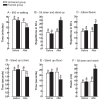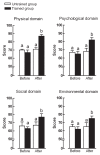Physical exercise improves the functional capacity and quality of life in patients with heart failure
- PMID: 18719752
- PMCID: PMC2664117
- DOI: 10.1590/s1807-59322008000400005
Physical exercise improves the functional capacity and quality of life in patients with heart failure
Abstract
Objective: The purpose of this study was to investigate the effects of physical exercise on the functional capacity and quality of life in heart failure patients.
Methods: Forty-two patients of both sexes with heart failure of NYHA class II and III with different etiologies were randomly divided into untrained or trained groups. The six-month exercise program consisted of aerobic training, muscle strength training, agility and joint flexibility activities. Physical fitness was evaluated by testing the performance on these trained components. Quality of life was evaluated by scored answers to a standardized questionnaire involving multiple domains.
Results: Baseline values did not differ between groups. Improvement in the trained group was identified in all components of functional capacity when compared to the untrained group (p<0.001). Quality of life improved in the trained patients concerning physical, psychological, social and environmental domains (p<0.001), whereas no significant change was found in the untrained patients.
Conclusions: Guided and monitored physical exercise is safe and has the potential to improve functional capacity and quality of life in heart failure patients with multiple etiologies.
Figures


References
-
- Sociedade Brasileira de Cardiologia. Diretriz latino-americana para avaliação e conduta na insuficiência cardíaca descondensada. Arquivos Brasileiros de Cardiologia. 2005;85:1–48.
-
- Hunt SA, Abraham WT, Chin MH, Feldman AM, Francis GS, Ganiats TG, et al. ACC/AHA 2005 Guideline Pdate for the Diagnosis and Management of Chronic Heart Failure in the Adult A Report of the American College of Cardiology/American Heart Association Task Force on Practice Guidelines (Writing Committee to Update the 2001 Guidelines for the Evaluation and Management of Heart Failure) Circulation. 2005;112:154–235. - PubMed
-
- Pescatello LS, Di Pietro L. Physical Activity in Older Adults: An Overview of Health Benefits. Sports Medicine. 1993;15:353–64. - PubMed
-
- Wielenga RP, Erdman R, Huisveld IA, Bol E, Dunselman PH, Baselier MR. Effect of Exercise Training on Quality of Life in Patients with Chronic Heart Failure. Journal Psychosom Research. 1998;45:459–64. - PubMed
-
- Dubach P, Sixt S, Meyers J. Exercise Training in Chronic Heart Failure: Why, When and How. Swiss Medical Weekly. 2001;13:510–14. - PubMed
Publication types
MeSH terms
LinkOut - more resources
Full Text Sources
Medical

